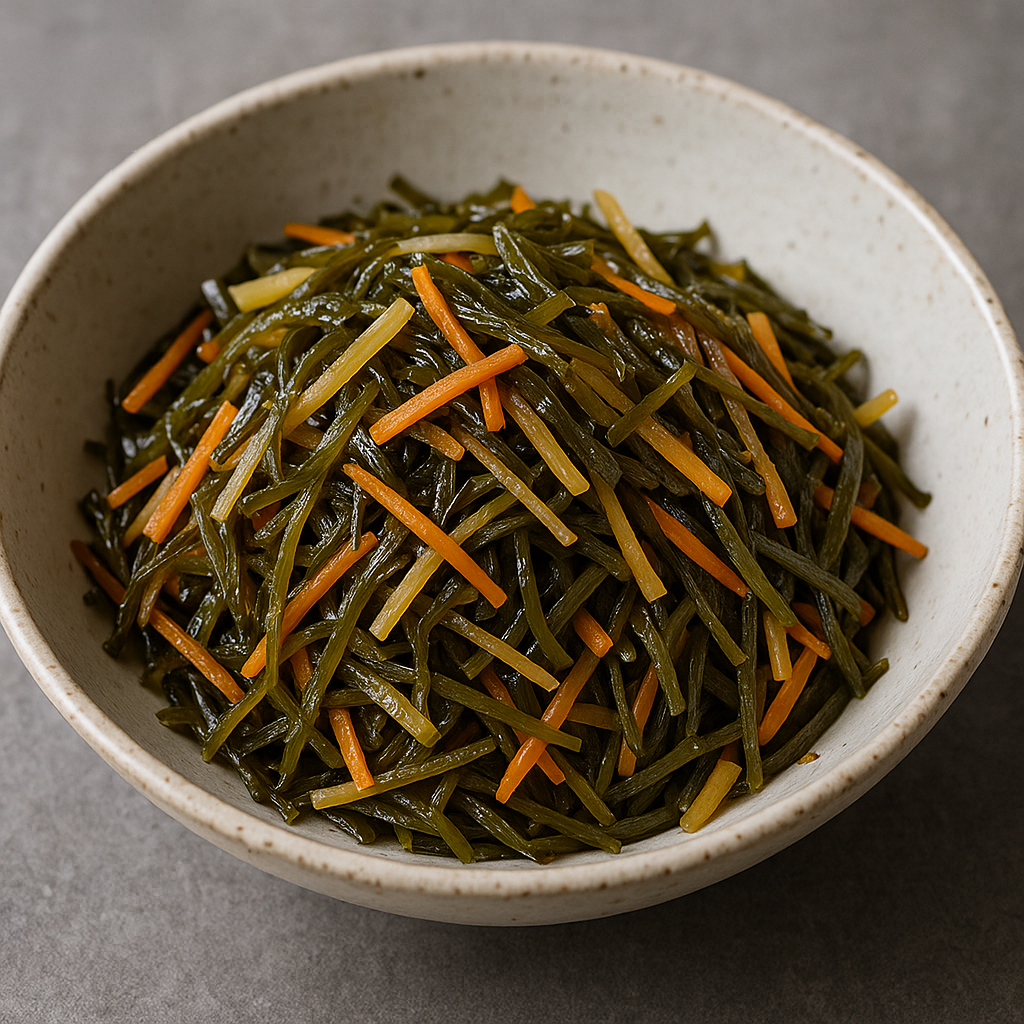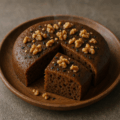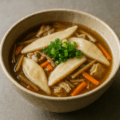すき昆布の煮物(岩手)の特徴
三陸発・細切り昆布を生かすやさしい常備菜
「すき昆布」は、昆布を薄く帯状に“すき”流して乾燥させた岩手沿岸の名産。戻してから根菜や油揚げと一緒に甘辛く煮含めると、磯の香りと素朴なうま味が広がります。冷めても味がのり、日々のおかずやお弁当に重宝します。
シャキッと歯ざわり、だし要らずのコク
昆布自体からだしが出るため、シンプルな調味でも深い味わい。戻しすぎず、歯ざわりを残して仕上げるのが美味しさのコツです。
すき昆布の煮物 レシピ
材料(4人分)
- すき昆布(乾)… 40g(戻して約200〜250g)
- にんじん … 80g(細切り)
- サラダ油 … 小さじ2
煮汁(目安)
- 水 … 250ml
- 醤油 … 大さじ2
- みりん … 大さじ2
- 砂糖 … 大さじ1(好みで加減)
- 酒 … 大さじ1
- ごま油…小さじ1(癖の無い油でもOK)
作り方
- 戻す:すき昆布はたっぷりの水に10〜15分浸けて戻し、軽く洗って水気をしぼる(長ければ食べやすく切る)。
- 炒める:鍋で少量の油を熱し、にんじんと昆布を炒める。
- 煮含める:水・酒・みりん・砂糖・醤油を加えて落とし蓋。中火で4〜5分加熱したら、汁気が少し残る程度まで調整しながら煮る。
- 仕上げ:火を止めて数分蒸らし、味を含ませる。器に盛り、好みで白ごまをひとつまみ。
シェフのワンポイントアドバイス
- 戻しすぎると食感が弱くなるため、短時間+しっかり水切りが基本。
- 煮詰めすぎないで“煮汁を少し”残すと、翌日もしっとりおいしい。
- コクを出したいときはツナ缶やサラダチキンなどを少量加えると良いでしょう。
- 色々な具材を入れるレシピもありますが、シンプルでも美味しく作れます。
栄養価(1人分の目安)
- エネルギー:130〜200 kcal
- たんぱく質:7〜11 g
- 脂質:4〜8 g
- 炭水化物:16〜24 g
- 食物繊維・ミネラル(昆布・大豆由来)
歴史
海と里の“結び煮”として受け継がれる味
三陸沿岸で親しまれてきたすき昆布は保存性が高く、内陸にも広まって日常のおかずに定着。根菜や豆、油揚げと合わせた“結び”の煮物は、行事の折や作り置きにも重宝されてきました。
English Version
Simmered Suki Kombu (Iwate) — Features
A gentle everyday side from Sanriku
“Suki kombu” is an Iwate coastal specialty: kelp that’s shaved into thin ribbons and dried. After rehydrating, simmer it sweet–savory with simple companions like carrot or fried tofu to draw out its ocean aroma and modest umami. It keeps its flavor even when cool, so it’s great for daily meals and bento.
Crisp bite, built-in broth
Kombu releases its own stock, so even simple seasoning tastes deep. Don’t over-soak—leaving a little bite is the key to a satisfying finish.
Recipe
Ingredients (Serves 4)
- Dried suki kombu … 40 g (rehydrated to about 200–250 g)
- Carrot … 80 g (thin matchsticks)
- Neutral oil … 2 tsp
Braising liquid (guideline)
- Water … 250 ml
- Soy sauce … 2 Tbsp
- Mirin … 2 Tbsp
- Sugar … 1 Tbsp (to taste)
- Sake … 1 Tbsp
- Sesame oil … 1 tsp (a neutral oil is also fine)
Directions
- Rehydrate: Soak suki kombu in plenty of water for 10–15 minutes. Rinse lightly and squeeze out excess water. If strands are long, cut to bite size.
- Sauté: Heat a little oil in a pot. Add carrot and kombu, and sauté briefly.
- Braise: Add water, sake, mirin, sugar, and soy sauce. Cover with a drop lid and simmer over medium heat for 4–5 minutes, then continue until a small amount of liquid remains.
- Finish: Turn off the heat, drizzle in sesame oil, and let stand a few minutes to absorb flavors. Plate and, if you like, sprinkle a pinch of white sesame.
Chef’s Tips
- Avoid over-soaking; short soak + thorough squeezing preserves texture.
- Leave a little sauce in the pot—this keeps it moist and tasty the next day.
- For extra body, add a spoonful of canned tuna or chopped salad chicken.
- It’s delicious kept simple, but you can add other vegetables if you prefer.
Nutrition (per serving, approx.)
- Energy: 130–200 kcal
- Protein: 7–11 g
- Fat: 4–8 g
- Carbohydrates: 16–24 g
- Dietary fiber & minerals (from kombu)
History
A “tied-together” braise linking sea and land
With its keeping quality, suki kombu spread from the Sanriku coast into inland kitchens and became a daily staple. Simmered together with roots, beans, and tofu, it’s long served for gatherings and as a make-ahead side throughout the region.



何でも質問してください!